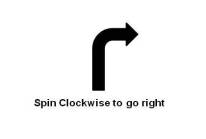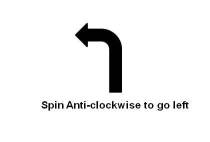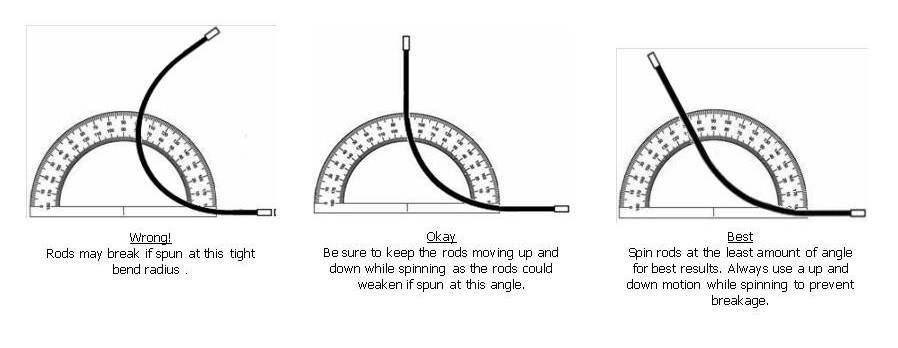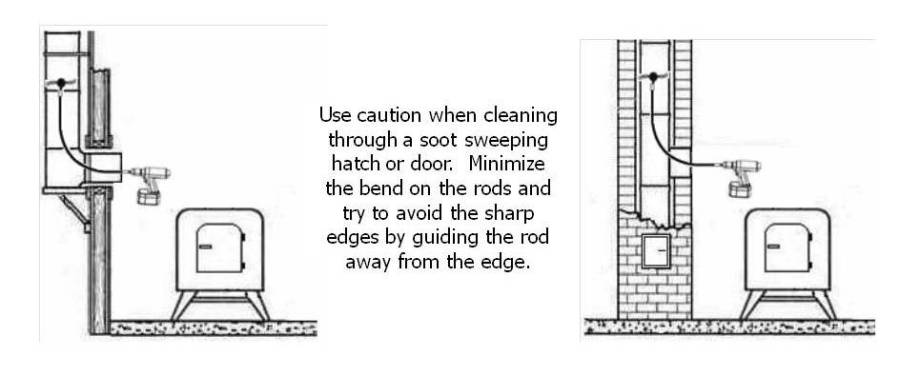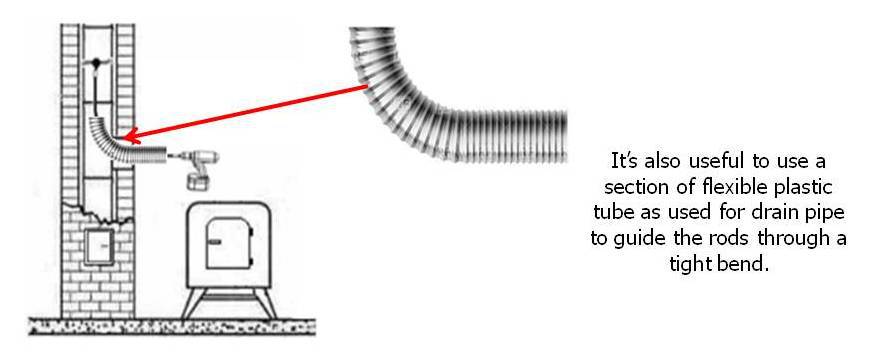
SnapLok Rotary Sweeping Instruction Manual
Index
- About SnapLok
- General Safety & Operating Tips
- Drills
- Construction & Uses of Rods & Whip Heads
- General Use & Maintenance
- Preventing Breakages
- Sweeping Methods
- Warranty
- Instruction Download
1. About SnapLok
SnapLok is the next generation of power sweeping technology with several patents pending. Our mission is to provide state-of-the-art technology at an affordable price.
The SnapLok line of innovative products was designed and developed by a long time chimney and duct cleaning professional with more than 25 years’ experience. We patented the original ButtonLok system back in 2001 that others have either copied or modified and then claimed as their own. We created the power sweeping industry more than 15 years ago and now we are excited to bring our new SnapLok equipment to sweeps around the world.
The SnapLok Power Sweep System uses our patent pending “Dual Button - Push & Lock” connection. This design makes the connection
extremely strong and allows the rods to be connected faster with a slight twist of the rod to lock the buttons into place.
Other power sweep system connectors require more twisting to lock a single button into place while others are “keyed” and require lining up a flat spot (or keyed area), before the rods can be pushed together for connection. This can be very time consuming and tedious.
The SnapLok Advantage
• Push Connect - No Need to Press Buttons
• Fast & Easy to Disconnect
• Strong, Dual Button Locking System
• Industry Proven and Preferred Over Any Other Rod System
• Affordable - Nearly Half the Cost of Our Competitors
• Patent Pending
2. General Safety & Operating Tips
- Always wear appropriate eye protection, clothing, gloves and respirator or dust mask.
- Work on ladders and roofs should only be attempted by experienced individuals that have the proper knowledge and ability to execute all safety procedures.
- Be aware of all electrical hazards when working with ladders and all other equipment.
- Keep all loose clothing tucked in to prevent being tangled in rotating rods.
- Add one rod at a time when spinning into chimney.
- Do not use rubber or grip type gloves, as these can get caught up and injury will occur.
- Always use suitable heavy duty or leather gloves when rotary sweeping.
- Never use a mains powered drill, as they generally do not have an adjustable torque setting. The reason we recommend a drill that has an adjustable torque is so that if you catch an unseen obstacle in a chimney flue, then rather the drill break your fingers or wrist, then drill takes the brunt of the twisting and activate the drill torque adjuster.
3. Drills
We recommend using any good brand of cordless drill with 18V or higher that has an adjustable clutch and a minimum of 2.6 Ah.
A higher Ah is best since this will provide more power and longer run time.
Be sure to purchase a 2nd battery and a spare drill adapter to avoid down time.
Higher voltage drills (24v – 36v) may be preferable when cleaning larger flues or using the larger 18mm solid nylon rods and can also be used when removing a bird’s nest or clay liner.
Important Notes
Always remember to set the clutch on a setting that allows the drill to stop spinning if it binds up suddenly. This will prevent injury and reduces the risk of property damage and damage to your equipment.
Do not use a corded (or mains) drill as they spin at too high of an RPM and generally do not have an adjustable clutch.
The high speed can cause the rod material to heat up quickly which will weaken the rod and increase the likelihood of breakage.
Without a clutch, you are at risk of injury if the rods bind or catch suddenly. The clutch allows the drill to stop spinning so it does not twist or break your wrist.
4. Construction & Uses
Rod Construction & Uses
- 8mm (SnapLok Jr.) Solid Nylon Rods: Used for biomass, gas and oil flues up to 150mm (6") dia. They are extremely flexible for tight bends and have brass fittings for corrosion resistance.
- 12mm Solid Nylon Rods: Widely used for 5” – 8” liner cleaning but can also be used as a leader rod in tight bend situations. They have great flexibility with excellent durability.
- 15mm Solid Nylon Rods: These rods have a good mix of flexibility yet somewhat ridged for a wide range of power sweeping applications. Good as leader rods or stand alone for smaller flues but generally too stiff for liner cleaning.
- 18mm Solid Nylon Rods: These rods are extremely durable, fairly stiff (with a slight flex) and used for power sweeping larger flues or tile breaking and nest removal. They have a little weight when several are connected but they are must have for the times there is no substitute.
- 22mm Polypropylene Rods: These rods work great for power sweeping taller flues or for all types of manual sweeping. They are lightweight, durable and semi-rigid. Add a few 15mm solid nylon rods as a leader to help guide through bends and offsets.
Fittings/Ferrules:
- 22mm Polypropylene rods, 18mm & 15mm Solid Nylon Rods: The fittings/ferrules on the 22mm PP rods, 18mm & 15mm solid nylon rods are made of steel that has been heat treated for superior strength and then double zinc plated for corrosion resistance. They are then double crimped and pinned to the rods to form a torque tested locking fit to each rod end.
- 12mm Solid Nylon Rods: The 12mm nylon rod fittings/ferrules are made of aircraft aluminum for superior strength and anodized for corrosion resistance. They are extremely light making the rods featherweight compared to brass or steel fittings. Each fitting is double crimped and the rod ends and have been torque tested to ensure years of use without issue.
- 8mm Solid Nylon Rods: The 8mm nylon rod fittings/ferrules are made of brass to resist corrosion. The fittings/ferrules are double crimped to create a solid connection to the rod.
Sweeping Whip Heads
SnapLok have designed new and innovative sweeping heads and continue to improve on the design, function and ease of use. Our heads are durable and easy to replace the whip line, cable or chain.
The nylon whip line is 6-sided industrial strength nylon, made of a unique, high tensile strength for peak effectiveness and durability.
Below is a description of our current sweeping heads:
- 4"/102mm Propeller Brush w/Brass Fitting:
Used for biomass, gas and oil flues (fits 8mm SnapLok Jr. Rods)
- 5"/127mm Propeller Brush w/Brass Fitting:
Used for biomass, gas and oil flues (fits 8mm SnapLok Jr. Rods)
- 5"/127mm dia. Bullet Whip w/Brass Fitting:
Used for biomass, gas and oil flues (fits 8mm SnapLok Jr. Rods)
- 9”/230mm BulletWhip:
The small core of this whip makes it ideal for feeding into small areas or past dampers. It’s molded from industrial nylon for superior strength and won’t damage liner systems. The 9” dia. is a perfect choice for stainless steel stove liners and insulated chimneys.
- 12”/300mm BulletWhip:
Same features as the 9” BulletWhip with slightly longer line for both liners and smaller masonry flues.
- 18”/450mm PowerWhip:
This head uses a sligtly larger whip line and is used for everyday sweeping.
- 24”/600mm PowerWhip:
Also used for everyday sweeping.
- 36”/900mm PowerWhip:
Used to clean extra-large flues yet will fit through extremely tight areas.
Specialist Whip Heads
NOTE: Specialist Whip heads are NOT to be used in stainless steel chimneys or liners as it can cause damage.
- ChainWhip:
Adjustable from 12” (300mm) to 18” (450mm). Our Patent Pending design makes it the fastest and most user friendly chain cleaning head on the market.
Use this for removing glazed creosote or tar in clay lined chimneys.
DO NOT use in stainless steel chimneys or liners as it can cause damage. Use with caution and do not spin in one place for too long. Keep the rods moving up & down (or in & out) and remember that the faster you spin, the more aggressive the cleaning action.
To adjust the length of the chains or to replace, simply depress the dual buttons on the body of the head and slide apart. Lay the base hub on a flat surface and slide the links onto the standoffs. Finally, slide the main hub onto the shaft of the base hub and twist slightly to lock.
- 18”/450mm CableLoop:
Another alternative to remove lighter tar or glazed creasote without the aggressive
action of the ChainWhip.
DO NOT use in stainless steel chimneys or liners as it can cause damage. Use with caution and do not spin in one place for too long. Keep the rods moving up & down (or in & out) and remember that the faster you spin, the more aggressive the cleaning action.
To replace the cable, loosen the grub/set screws and insert the new cable making certain the loops are close to the same size then tighten securely. Pull on the loops to ensure they can be removed.
- Retrieval/Nest Removal Tool:
This tool is used by hand (without the drill) to retrieve a lost brush or to screw into a nest and pull it out. Made of heavy gauge, heat treated steel.
NOTE: This MANUAL tool must NOT be used with a drill and spun in a flue
- 18”/450mm CableWhip with Welded Ends:
This head works great for removing birds nests. Push the head up into the nesting then start spinning. Work it in both directions and it will break up the nesting material.
Important Note: Be sure the clutch is set on your drill before spinning in case the head binds up. If you get stuck, reverse the direction of the drill and back your way out.
- 18”/450mm CableWhip with Frayed Ends:
This head is a less aggressive alternative to the ChainWhip that can provide a sraping action on larger flues where the frayed ends can expand outward and contact the flue surface. In smaller flues, the sides of the cable provide moderate cleaning action.
Use with caution and do not spin in one place for too long. Keep the rods moving up & down (or in & out) and remember that the faster you spin, the more aggressive the cleaning action.
Replacing the cable on both CableWhips:
It’s very fast and easy to replace the cable in both heads.
1. Simply loosen the grub screw located on the inside of the fitting. Make sure it’s completely backed out almost to the point of removal but it is not necessary to completely remove the screw.
2. Remove the old cable and replace with new.
3. Be sure to center the cable in the head.
4. Tighten the grub screw securely and pull on the cables to ensure they are tight and cannot move.
Adapters
Adapters are available to connect SnapLok equipment to any other leading brand of rods, cleaning heads, brushes, etc. – rotary or non-rotary.
5. General Rod Use
- As mentioned earlier, only use a cordless drill with an adjustable clutch. Set the clutch at a halfway setting or less. You should be able to hold the chuck tightly in your hand get and stop it from spinning. Increase slightly if needed but you want to be sure the drill stops spinning in an instant if the rods catch in the chimney.
- Gloves: Use a thicker glove that “does not” have any grip to it. You don’t want them to get caught on the spinning rods which can cause injury. Never use thin latex gloves as they will surely wind up on the spinning rod and be torn from your hands. Keep all loose clothing tucked in to prevent being tangled in rotating rods.
- Connecting the Rods; SnapLok rods are the fastest and most user friendly rods on the market. Simply push the rods together and give them a slight twist in either direction until you hear them lock. Usually a ¼ turn is all it takes. No need to depress the buttons to connect with our “Push Lock” system.
- Disconnecting the rods; Pinch the two buttons at the same time and pull apart.
- Keep the rods as straight as possible when connecting or disconnecting each rod. This can be done by slightly bending the rod you are connecting to (or disconnecting from) in order to keep the angle as straight as possible for the rod you are connecting (or disconnecting).
- If you encounter a snag or obstacle that causes the drill to bind, reverse the direction of the drill and slowly spin in the opposite direction to unwind or back out of the snag.
- When spinning through offsets, sharp bends or in larger flues, keep in mind that spinning the rods in a “clockwise” direction will pull the head to the right.
Likewise, spinning “counterclockwise” will pull the head to the left
Maintenance
Be sure to wipe the rod fittings/ferrules off frequently then spray them with a silicone spray or light oil. You may also want to hose them off with water then wipe them dry before spraying them with a light silicone spray or oil.
Replacement Rod Ends
Replacement ends are now available for all rod sizes. Simply cut the rod near the end of the fitting/ferrule, slide a new end on, drill then double pin.
Replacing the Whip Line
It’s very fast and easy to replace the whip line in both the BulletWhip heads and the PowerWhip heads.
- Simply loosen the grub screw located on the inside of the fitting. Make sure it’s completely backed out almost to the point of removal but it is not necessary to completely remove the screw.
- Remove the old strands and replace with the proper sized new strands.
- Be sure to center the strands in the head and rotate each set in opposite directions to form the pattern shown in the photos.
- Tighten the grub screw securely and pull on the top set of strands to ensure they are tight and cannot move.
6. Preventing Breakages
- To avoid rod breakage, never spin rods in sharp/tight bend angles as shown below.
- Only use a cordless drill with adjustable clutch.
- Always use a “Back & Forth” motion while spinning rods to
1) Prevent the rods from heating up and becoming weak or
2) Prevent screws in flue pipe from cutting through rods.
To help prevent rod breakage, avoid spinning the rods at sharp bends and keep the rods moving up and down while spinning to prevent the rods from heating up.
Cowls
Some cowls can be very sharp, and the effect of spinning the rod against these objects can cut a rod.
To sweep these flues it is important to try not to exit the cowl as this could damage your rod.
Leader rods
Be sure to rotate your leader rods by not using the same rod over and over again as a leader. Using one rod as a leader will weaken the rod over time which may cause the rod to break.
Cold Weather
It is highly recommended to bring your rods inside during extremely cold weather (below -25°c or -15°F). Extremely cold temperatures will cause the rods to become brittle and may break. We also recommend allowing the rods to warm up slightly before using if they’ve been left out in these types of low temperatures.
7. General Rotary Power Sweeping Methods:
There are many different methods of rotary power sweeping. The following guide is meant to provide a few different options to get you started.
Most of the rotary whip heads and brushes are designed to fit through very small areas and then expand when spun to conform to various flue sizes and shapes.
For square and rectangle flues, spin in one direction for the entire length of one rod to get two opposing corners. Then reverse the drill to spin in the opposite direction to clean the other two opposing corners. Do this for each rod you add.
To clean deeper into the corners, use a slower speed. This will allow the whip line, cable or chains to reach further into the corners.
For round flues you can spin in the same direction the entire distance/height unless you need to navigate a corner. In this case, use the method mentioned above.
You will develop a feel for power sweeping over time, but in general, the faster you spin the more aggressive the cleaning action. The slower you spin, the less aggressive the cleaning action.
Use a slower speed when cleaning older, unlined flues or reaching into the corners.
Use a faster speed, as needed, when cleaning lined flues or flues with heavy build-up.
Be sure to keep the rods moving up & down (in & out) to avoid damaging mortar joints, etc.
Cleaning Option 1:
This is the preferred way of rotary sweeping, particularly in flue liners.
- Feed the rods from the bottom up “without spinning” – then spin your way back down.
- Attach the appropriate cleaning head and begin feed the rods up into the flue until you reach the top. You can tell when you are out the top because the rods will get very easy to push. If there is a cap/cowl on top of the flue, use caution when you feel you are getting close to the top to avoid knocking the cap/cowl off.
- Once you are out the top, pull the rods back down and begin spinning once the head is inside the flue again. If spinning inside the cap/cowl to clean it, use caution and spin at a slower speed. Continue spinning your way back down.
Advantages to using this method:
- If there is a blockage (such as a birds nest), it can be discovered without running into it while the rods are spinning.
- If spinning on your way up, you are at higher risk of knocking the cap/cowl off.
Cleaning Option 2:
Cleaning from the top down:
- Be sure you are sealed up at the bottom and your vacuum is running (if you are using one) to prevent dust from escaping into the home while cleaning.
- Use caution when connecting and disconnect the rods to avoid dropping them down the flue. Again, you may want to push the rods in as far as you can by hand to ensure there is no blockage before spinning with the drill.
Important Note:
Whenever feeding from the bottom up, be aware that some older chimneys have multiple flues that connect. This can result in your rods crossing over into an adjacent flue then leading you to the top.
You may feel you have thoroughly cleaned the proper flue but it could in fact have a birds nest. Rare, but it can happen.
8. Limited Warranty
The SnapLok rods and all accessories are designed for professional use only.
All components are warranted for a period of 12 months from date of purchase.
Should any part fail due to manufacturing defect, return the defective part to SnapLok and we will replace it free of charge.
All parts must be returned and inspected to determine part failure. A return authorization number is required prior to returning any item. SnapLok does not warranty failure of any part due to operator error or normal wear.
Normal wear items not covered include, but not limited to, nylon whip line, chains, cable wire, bent rods, etc.
Be sure to read all operating instructions and safety precautions before operating any of the tools.
Manufacturer accepts no liability for property damage or personal injury resulting from the operation of these tools and accessories. This is the full extent of the warranty made by SnapLok. There is no other expressed warranty. All implied warranties are hereby excluded.
9. Instructions Download
Instructions that can be downloaded for rotary power sweeping.
SnapLok User Manual Print.pdf
Adobe Acrobat document [893.8 KB]
Likewise, spinning “counterclockwise” will pull the head to the left.
